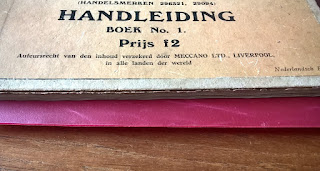Old manuals can have torn pages. All older paperwork of course can be damaged, but especially instruction manuals will be prone to tears in the pages. Also (folded) leaflets that come with machines often have damage.
A while ago I purchased this instruction manual 'Book 1' from 1924. This is over 200 pages, so a good thing that it was bound, instead of still the standard stapled booklet.
This book of models was always used very carefully. It must have been, to have survived this long in this fine condition. Nevertheless, a lot of its pages had tears - some smaller, some larger. As example, the small tear in page 115.
As the book is intended to be used again with a Meccano set of similar vintage, these tears should be stopped from becoming larger.
To fixate these tears, a very small amount of PVA glue was used. This is excellent for glueing slightly porous materials and it will not adhere to smooth, closed surfaces. As the surface to be fixed again is minute, an equally small amount of glue must be used - otherwise the moisture from the glue will wrinkle and damage the paper. Also, because it is so small a strip of glued material the extra local stiffness does not hinder the page.
Before applying with the finger or a toothpick a diminutive strip of glue, a plastic binder is slipped under the page.
This will prevent other pages from getting any glue, and the PVA will not adhere to it. (I later found out that wax-paper is generally used for this.) When the tear has been 'closed' again properly (with the right side on top, tears are rarely vertical through the paper), then the binder is closed to cover the glued page. Then closing the book ensures everything is straight and flat. (Add extra weight if needed...)
Letting it harden for a few minutes, the book can then be re-opened and the plastic binder can be taken away. The tear is not quite invisible, but it is fixated and will not tear further.
Just about every other few pages a tear was fixated this way - making the book fine to use again. Lots of little mechanical 3-dimensional puzzles.
Like a little monoplane.
Or a potato-spinner.
Fun stuff, and the instruction manual now again good to go for several more decades!







No comments:
Post a Comment